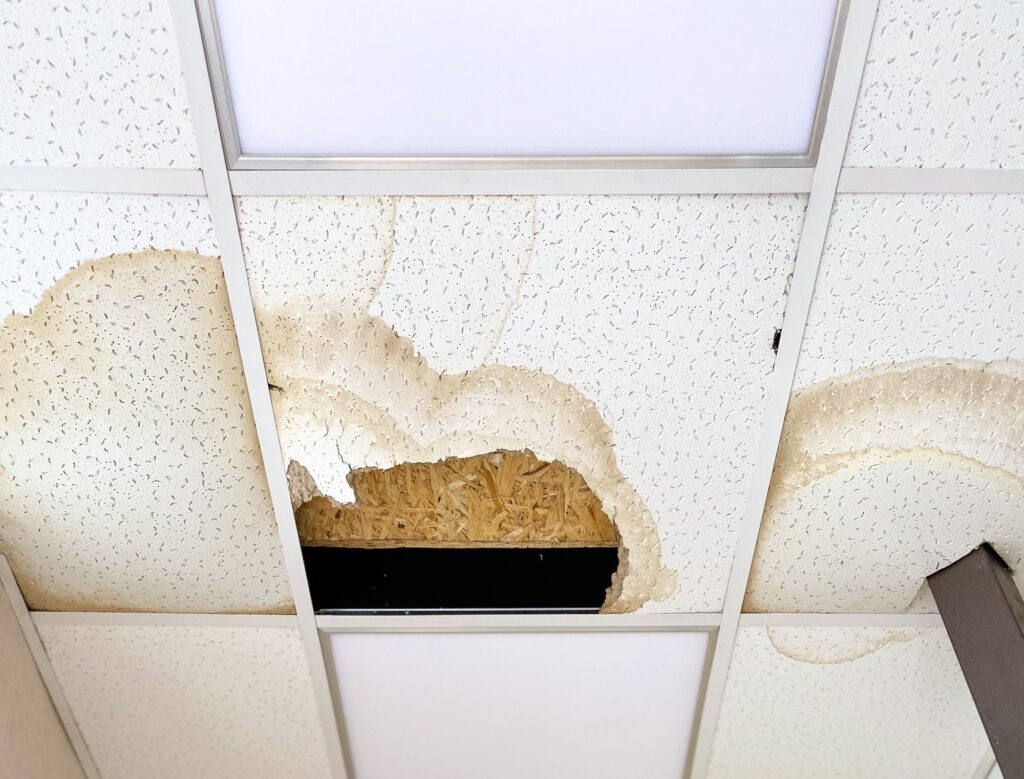Ceiling water damage isn’t something you can just shrug off. It often sneaks up—maybe you notice a weird brown stain, some paint bubbling, or a crack that wasn’t there last week. Those little signs might be the tip of the iceberg, hinting at a leaky pipe or roof problem lurking above your head.
Fixing water damage on your ceiling quickly can prevent expensive repairs and stop mold from growing. If you act fast, you can limit the damage before it spreads and gets worse. Understanding the causes and knowing what steps to take helps you fix the issue safely and keep your home in good shape.
Almost every homeowner runs into this at some point. It’s surprising how fast a tiny drip can lead to a whole section of ceiling that needs replacing. Spotting the early warning signs and knowing how to react could spare you a lot of hassle—and money. Professional repairs? They can run $45-$55 per square foot so it’s worth paying attention.
Understanding Ceiling Water Damage
Ceiling water damage isn’t just ugly—it can mess with your home’s safety too. Knowing where it comes from and what it looks like helps you jump on the problem before it spirals.
Common Causes of Ceiling Water Damage
Leaks or water pooling above your ceiling are usually to blame. Leaking roofs top the list, especially if you’ve got missing shingles or your gutters are a mess. Heavy rain, melting snow, or storms just make these leaks worse, letting water sneak inside.
Burst or leaking pipes in the walls or attic are another headache. Even a tiny, slow drip from a pipe can build up over time, eventually wrecking the ceiling below. Sometimes, your HVAC system is the culprit—if the condensate line clogs, moisture can collect and cause problems.
If you live in a multi-story place, a bathroom leak or an overflowing tub upstairs can lead to water coming down through the ceiling. Appliances like washing machines or dishwashers (when they’re upstairs) are also common troublemakers. For a deeper dive, check out this list of common causes.
Types of Ceiling Water Leak
There’s more than one way for water to mess up your ceiling. Steady leaks usually come from a broken pipe, sending water down non-stop and often leading to sagging or even collapse if left unchecked.
Intermittent leaks are sneakier. These often happen during storms or when a certain appliance is running, so they’re easy to miss. Then there are slow, hidden leaks from tiny pipe drips—those can take weeks or months to show but still do plenty of damage.
Leaks can change or stop as pipes expand, contract, or shift. Here’s a quick breakdown:
- Steady leaks: constant, visible water
- Occasional leaks: show up during rain
- Minor leaks: slow signs like peeling paint
Each one brings its own headaches, from a small ceiling water damage problem to a full-blown repair job. Catching them early really does save money and stress.
Identifying Ceiling Water Stain
Ceiling water stains usually show up as brown or yellowish marks that don’t blend in with the rest of your ceiling. They often have irregular borders and might get bigger if the leak keeps going.
Keep an eye out for:
- Peeling or bubbling paint
- Drooping or sagging spots
- Cracks around seams
If water sits too long, mold or mildew can start growing. Even a tiny stain can mean there’s a bigger problem hiding above. Sometimes the visible signs are just the beginning, as this explanation of ceiling water damage signs points out. It’s always smart to check things out quickly.
Assessment and Diagnosis

Ceiling water damage needs attention right away, but you’ve got to know what you’re looking for. Spotting the signs early can save you from a much bigger headache down the road.
How to Detect Signs of Water Damage
There are some dead giveaways when it comes to ceiling water damage. Stains or discoloration are usually the first thing you’ll notice—yellow, brown, maybe even copper-colored spots. They don’t stay small for long, either.
Peeling or bubbling paint (or wallpaper) is another red flag. If the ceiling feels soft or you see cracks and sagging, the water’s been there a while. Mold spots or dark streaks mean the leak’s probably not new. Sometimes you’ll catch a musty smell even before you see anything.
It helps to use a flashlight—check corners and spots near light fixtures, especially after a big rainstorm or if there’s a bathroom above.
Evaluating the Severity of the Damage
Figuring out how bad the water damage is tells you what to do next. If it’s just a small stain or a bit of soft drywall, the leak was probably short-lived and a quick fix might do the trick.
But if the spot feels soft, is spreading, or there’s sagging, water could have soaked deeper into the ceiling. Buckling, blistered paint, or warped drywall? That’s a sign things are getting worse. If you smell mold or that earthy funk, the problem’s been around a while.
Try to check if the framing or insulation above the ceiling is wet. Sometimes you’ll have to cut away a bit of drywall to get a good look, especially when the leak’s source isn’t obvious.
Ceiling Water Damage Repair and Restoration
Acting fast makes a huge difference with water damage. A careful, step-by-step approach helps you fix things right and keeps more problems from popping up later.
Steps to Fix Ceiling Water Damage
First things first—find the leak and stop it. If it’s a plumbing issue, shut off the water. Check the roof or pipes for obvious problems. Mop up any standing water with towels or a wet vac.
Once the water’s gone, let the ceiling dry out completely. Open windows, crank up some fans, or run a dehumidifier. If the drywall, insulation, or tiles are stained, swollen, or saggy, you’ll probably need to cut them out. Make sure you’ve gotten rid of any mold—clean it with water and mild detergent or a household mold remover.
Patch or swap out the damaged area with new drywall or ceiling panels. Smooth out rough spots, then prime and paint so it matches the rest.
Ceiling Water Damage Repair Cost
Costs really depend on how bad the damage is and what materials you need. Small repairs, like patching and painting, usually run $45 to $55 per square foot. That’s just for the ceiling—not fixing the original leak.
Bigger jobs or serious damage can get expensive fast, especially if you need to fix framing or electrical stuff. Sometimes you’re looking at thousands of dollars. It pays to get a few quotes from pros so you know what’s fair. Always double-check what the estimate covers before signing anything.
Preventing Recurring Damage
If you want to avoid doing this all over again, regular checks are your friend. Take a look at your roof every year—replace loose or missing shingles. Keep gutters clean and make sure downspouts send water away from the house. Watch for leaks around sinks, tubs, and toilets.
Try to keep indoor humidity down to stop mold before it starts. Use vent fans in bathrooms and kitchens, and fix leaks right away—even small ones. Staying on top of things is the best way to protect your ceiling (and your wallet).
Frequently Asked Questions
Ceiling water damage can be a real pain, both for your home’s looks and its safety. Spotting the signs and knowing what to do helps you dodge bigger problems.
Can water damaged ceiling be fixed?
Yes, most ceiling water damage can be fixed. You’ll need to find and stop the leak, get rid of damaged material, and patch or replace the bad spot. Sometimes, if it’s just a small stain, cleaning and painting is enough. For bigger messes or mold, you might want to call in a pro.
Is a water stain on a ceiling serious?
A water stain means something’s leaking. Even a tiny spot can mean water is sneaking into your home. If you ignore it, you could end up with mold, a weak ceiling, or much bigger repair bills. It’s smart to track down the source and deal with it right away—serious stains can’t wait.
How to identify water damage in a ceiling?
Look for stains—usually brown, yellow, or even rusty spots—that jump out against the rest of the ceiling. Sometimes you’ll notice sagging, bubbling paint, or peeling patches. And if you catch a musty odor, that’s often a red flag for hidden leaks or trapped moisture above.
How long does ceiling water damage take to dry?
Ceiling water damage usually dries out in a few days to a week, but honestly, it depends on how much water got in there, the airflow, and what kind of materials soaked it up. Fans and dehumidifiers? They help a lot. Still, just because it feels dry to the touch doesn’t mean there’s not moisture hiding underneath. You’ll want to be sure it’s completely dry before jumping into repairs, or you might end up with mold creeping in later.
